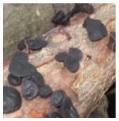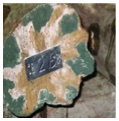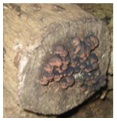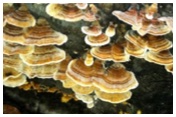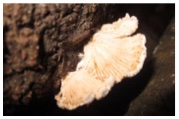Spawn Run & Incubation
Creating a Laying Yard
EXPERT TIPS: Monitor Your Mycelium
During the incubation period, you can monitor the growth of the mycelium by looking at the ends of the logs. Shiitake mycelium will appear white and often slightly fluffy at the end of the log.
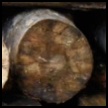
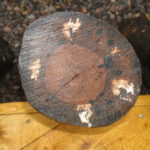
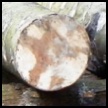
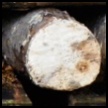
Before you begin, think about where you are going to keep all the logs once they are inoculated with mushroom spawn. This will become the laying yard: the place where the logs are incubated and routine maintenance is performed. The logs usually remain in the laying yard for the rest of their productive lifetime, which includes both fruiting and harvest.
Year-round shade (75 to 100 Percent) and High Humidity
Almost nothing is more important than laying (incubating) the logs under year-round shade in order to keep the logs from drying out due to sun and wind. A laying yard beneath the canopy of a coniferous forest is best. Hemlock provides especially dense shade. A deciduous canopy will suffice but it will be necessary to protect the logs with 80% shade cloth or pine boughs during the winter. For smaller operations in select circumstances, behind the north side of houses, sheds or other structures can provide effective, year-round shade.
Access and Relative Location
Ideally the laying yard should be accessible by a vehicle or tractor and close to your home/farm. You should also consider its proximity to electricity (necessary to inoculate the logs) and water (necessary to irrigate and soak the logs). You do not want to place a laying yard in any location that necessitates carrying the logs over any great distance, unless you are looking for a really good workout, or have a tractor or four-wheeler to transport them.
Proximity to Water and Water Source
A water source is necessary for forced fruiting (shocking) as well as for maintaining a threshold moisture level in the logs. Take into consideration how close and convenient each possible water source is. Particularly think about moving materials through the laying yard and common use patterns. If there is a dry spell and the logs must be wet down to maintain moisture levels, logs may be submerged under water for a few hours or wetted under a sprinkler for several hours. It is critical that the moisture content of the logs does not fall below a threshold necessary for the survival of the growing mushroom. Logs typically begin at about 40 to 45 percent moisture content and should not drop below 30 percent.
Ideally the water should come from a well, stream or public water system. Shocking is most successful when there is a significant temperature difference between ambient air and water for shocking. You can’t control air temperature in the woods, but you can choose a laying yard site that will have access to clean, cold water.
Other Considerations
Other important aspects of the laying yard include slope, microclimate and accessibility. The slope and microclimate of the laying yard will affect how you lay the logs. For example, if it is a site with lots of exposure to wind, one may choose to lay logs closer together to maintain log moisture. In the meantime, you might consider planting a windbreak. It is very important that the laying yard is accessible so that you may irrigate the logs if desired and check for fruiting regularly during the growing season. If it is necessary to incubate logs on a steep slope because level land is not available, the Japanese hill stacking method described below is worth considering.
EXPERT TIPS & TRICKS: What Makes a Good Laying Yard
“I do make it a priority to clean up organic debris primarily around my fruiting area and have noticed (subjectively) that this has cut down on slug damage. In some of my fruiting areas I have laid down gravel which the logs lay on when they are fruiting ... further seems to help with slugs.
“I don’t worry about organic matter where logs are not fruiting. I also find that there is enough air circulation even with shrubby undergrowth so only have cleared what I need to. I also get my log stacks off of the ground with locust as it is plentiful on my place and does a great job...but many things would work.
“For A-frame set-up I generally plan on about a foot of run to give me room to fruit 2 logs. So if you force 20 logs allow at least 10 feet of run...add a little extra just to add some breathing room.”
- Steve Sierigk, Hawk Meadow Farm
Below is a laying yard at Green Heron Growers.
Note the characteristics that make a successful and productive laying yard.
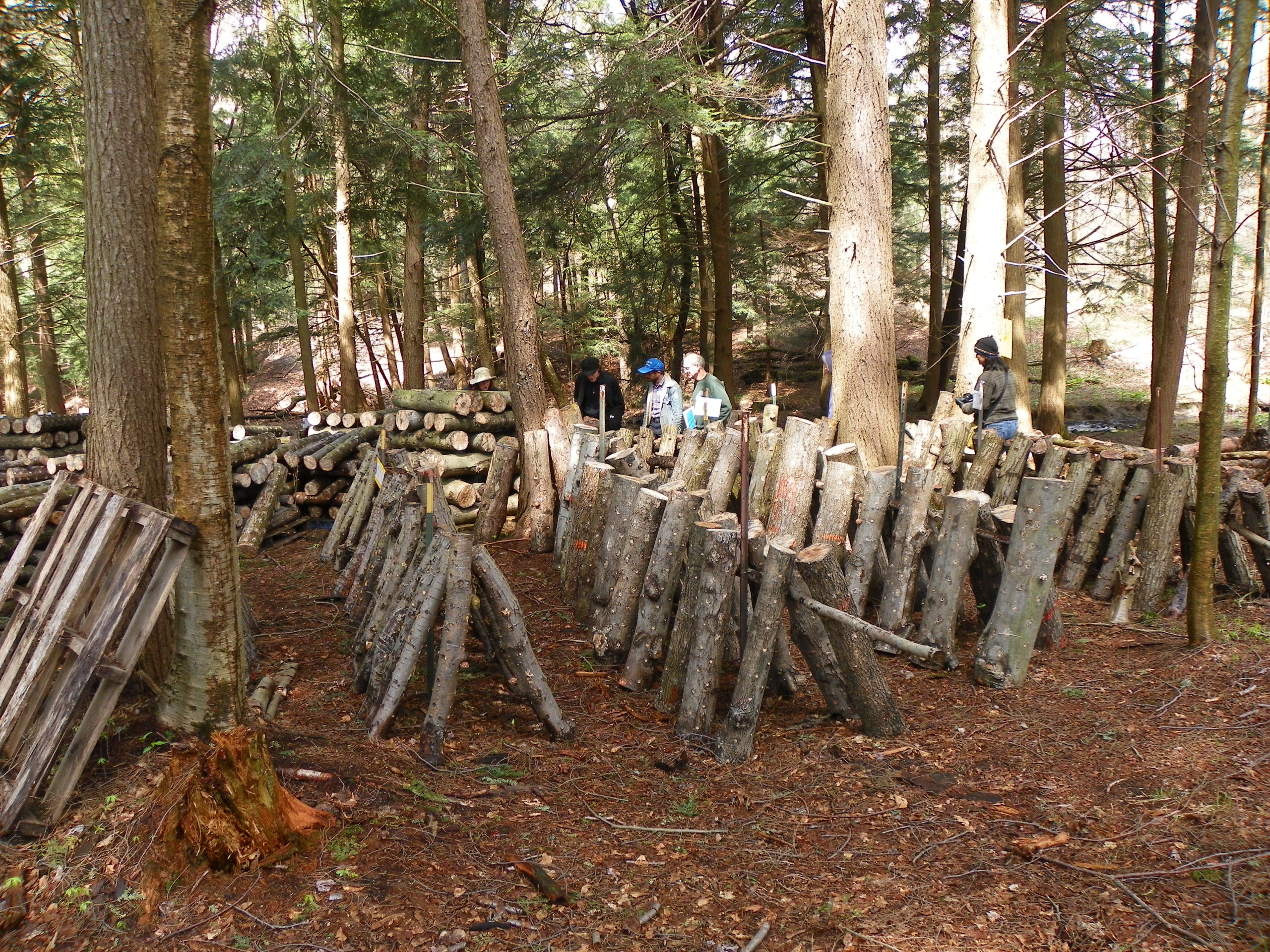
EXPERT OPINION: Crib Stacks
“Keep production stacks as loose crib stacks that you can get your hands into to harvest shiitake that randomly pop up.“
-Steve Sierigk, Hawk Meadow Farm
EXPERT TIPS: Hillside Stack
For more information on this stacking method see “our cultivation guide” featured on the Northern Mushroom growers website at http:// mushrooms.cals.cornell.edu/.
Incubation Period
After the logs are inoculated, they must go through an incubation period or “spawn run” during which the fungus colonize the wood. During this 8- to 18-month period, the fungus colonizes and decays the log.
This doesn’t mean you can forget about your logs for years; you will need to maintain favorable conditions for the shiitake mycelium so it can spread through the logs as quickly and evenly as possible. This could include main- tenance soaking to keep log moisture content well above 30 percent. Artificial shading may be necessary if the laying yard is under a deciduous canopy. At the same time, you will need to protect the logs against competing fungi. Your final productivity will largely depend on how well the shiitake fungus estab- lishes itself during spawn run, which in turn keeps competitive fungus at bay. Providing optimum growing conditions at this time is crucial!
Stacking the Logs during the Incubation Period
After the logs are inoculated, most growers place the logs in a crib stack. Crib stacks are simple and quick to make. First, four or five logs are laid down on a flat surface, then four logs are placed on top of them in the opposite direction, turned 90 degrees (or perpendicular to) the first layer. The pattern is continued for about five levels. The space between the logs in any layer should be 1 to 2 inches to assure proper aeration and allow leaf litter and other debris to fall through the stack over time. Crib stacks are a very space efficient way to keep logs as they make use of vertical space, compactly storing large numbers of logs. This stacking method is excellent for the spawn run period.
We recommend keeping the logs off the ground. Find some free pallets, dimensional lumber, or clean freshly cut logs, and use them as the base for each stack. Also helpful is to put larger logs on the outside and smaller ones on the inside, and to keep the stack balanced as you build up.
If you would like to store logs on steep hillsides, you may want to consider the Japanese Hillside Method. This stacking method is more complex to set up, and only recommended for steep hillsides. This technique creates a very stable, aerated stack in which mushrooms are highly visible and easy to pick. The majority of logs are also raised off the ground, potentially reducing slug damage.
EXPERT OPINION: Maintenance Soaking
“As a rule of thumb I would recommend 2 maintenance soaks during the initial spawn run. A minimum soak of 2 hours for all logs in the spawn run in early July and mid-August should keep your shii- take mycelium humming along nicely in most years.
“If your logs from last year are quite a ways from forcing I certainly would give them a maintenance soak during long bouts of hot dry, hot weather. My own yard is very protected from wind and direct sun so I don’t worry much about maintenance soaks especially once I have started forcing cycles in early June. However, if your laying yard is less than ideal with sun and wind factoring in more, you may want to do a mainte- nance soak ... but do keep these soaks very short (1 to 2 hours) to not trigger a flush. When logs are 4 weeks out from a forcing, I empty my soaking tanks weekly on stacks (buckets of water method) that are a month away from a forcing to give them an artificial rain shower. My soaking tanks hold about 12 to 14 logs comfortably so it is a good way to hydrate logs quickly if I am in the yard for a few hours. “
- Steve Sierigk, Hawk Meadow Farm
“We have never done maintenance soakings. We have used sprinklers once in 5 years. Too many other things to do and too many logs! Maybe some logs have dried out earlier than they might have otherwise. Hard to know. We get three good years out of our logs, two flushes a season.”
- Steve and Julie Rockcastle, Green Heron Growers
EXPERT TIPS: Putting it all in Perspective
“For perspective I look back in amazement at my first group of 100 shiitake logs I did back in the 1980s. I had way too many projects going on at the time and these logs were left to their own fate. In retrospect the laying yard was crummy... a hardwood forest that let too much light and wind in. I never ever soaked these logs.
“These logs amazingly produced shiitakes for eight years, generally one flush per year before we gave up on them. Even though this was an impractical set-up it taught me that the logs are very resilient.
“Now since I am trying to rely on a weekly harvest promised out to restaurants, I try to keep the logs humming along as best I can without going crazy about maintaining moisture content. I always remember my early logs and know that disaster will not ensue if I just don’t have the time to water."
-Steve Sierigk, Hawk Meadow Farm
EXPERT TIPS: Fungal Competitors
“Growers should be aware of the fungal competitors that are out there, some basic ID tools, and ways to minimize their occurrence. Even if you notice competitive fungi growing on a log, don’t lose hope; ultimately shiitakes will probably still hang in there to some degree. Hypoxylon seems to be the worst and can be largely avoided by avoiding excessive exposure to direct sun for extended periods.”
-Steve Sierigk, Hawk Meadow Farm
EXPERT TIPS: Trichoderma Treatment
Determining if the trichoderma is penetrating into the wood is not as easy as it may seem because the mycelium is white (like shiitake), not green – only the spores are green, and the fungus does not sporulate within the wood, so don’t expect to see green wood.
What are some northeastern growers really doing about trichoderma? Two references do not prescribe any action or treatment, two references say that you should increase ventilation and reduce humidity around the logs, and the last two references state that you should remove the infected logs, with one of those stating that the logs should be destroyed. Many growers are also spraying infected logs with 5 percent hydrogen peroxide to kill the trichoderma on the surface of the bark so that spores won’t be produced and released into the air to infect new logs.
EXPERT TIPS: Conditions that favor Competitors
“As far as competitors go ... I feel like hypoxylon got a foothold during the 2012 spawn run in some of my logs as I was inoculating late into the season and it was so hot and dry. I have read that hypoxylon is not compatible with shiitake colonization and have taken these badly affected logs out of the yard ... some have minor shiitake colonization but are not worth managing. I have had minor amounts of hypoxylon pop up over the years especially in one of my yards that gets a bit too much sun. Also split gill fungus seems to have been a problem on my oak logs that also got too much sunlight during the late attempts at inoculation...shiitake and split gill somewhat coexist but it seems to really reduce yields. All the more reason to get on inoculation early. “
-Steve Sierigk, Hawk Meadow Farm
Moisture Management
It is important to ensure that the logs stay moist during the incubation period. Shiitake spawn cannot survive in logs that have a moisture content (the amount of available water in the log, expressed as a percent of the fresh weight) of less than 23 percent. Ideal moisture conditions for shiitake growth are log moisture content is 35 percent or more.
Shade
Keeping the logs shaded during the warm summer months will help main- tain higher levels log moisture. Keeping logs shaded or snow covered during winter will ensure that the typically dry winter air does not dry out the logs. An evergreen canopy will shade the logs year-round. A thick deciduous canopy during the summer months will generally suffice, but a shading strategy needs to be employed for months with no leaf cover.
This can vary from a structure covered with shade cloth (70 percent), or simply by covering the logs with shade cloth. Professional greenhouse shade cloth is ideal, but burlap will suffice. Do use an opaque covering. If shade cloth is draped over crib stacks during winter, care should be taken to remove shade cloth when tem- peratures rise in the spring, to avoid drying and encouraging competitive fungi to grow under the cloth or tarp.
Moisture Maintenance
In addition to keeping the logs shaded, you may want to consider dousing them with water occasionally during warm, dry summer months. This could be accomplished either using a simple hose and sprinkler system or a good soak for at least several hours is generally enough. If the logs are primed this might actually trigger a flush, so keep an eye on them after soaking. Expert growers recommend limiting maintenance soaks to no more than two hours. See sidebar on left.
It can be difficult to know when to initiate a maintenance soak. You can measure the moisture content of the log by cutting off a section of the log (known as a cookie), weighing it, drying it over 12 hours, and reweighing it. The moisture content of the log will be equal to the weight of water that evaporated during drying (wet weight minus dry weight), divided by the wet weight. [%M = FW-DW/FW]. You could use this to judge the necessity of a maintenance soak. However this process is very time consuming and is not often appropriate for commercial enterprises. Moreover, professional electronic moisture meters designed for the forest products industry are not a reliable way to determine log moisture content for mushroom logs.
Instead, most experts decide whether or not to initiate a maintenance soaking based of the age of the log, tree species, weather and laying yard con- ditions. When deciding for yourself when to perform a maintenance soak, keep in mind that different wood species seem to retain moisture better than others. Red oak logs hold their moisture fairly well; bitternut hickory logs lose water much faster. It’s important to use your personal observations and intuition in determining when to perform maintenance soakings.
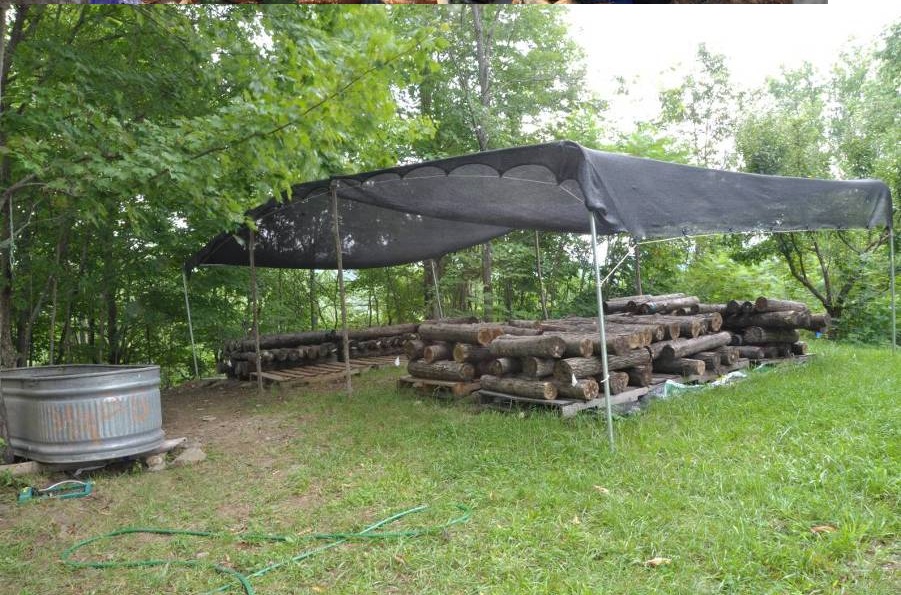
Contamination by Competitive Fungi: Excerpt by Steve Sierigk, Hawk Meadow Farm
Avoiding Contamination
Fungal competitors of your shiitake logs are always an issue even with the best management. It is impossible to block other wood-inhabiting fungi from the logs used in outdoor shiitake cultivation, because the spores of competi- tive fungi are naturally carried in the air. These spores can quickly establish a new colony when exposed to a suitable substrate under favorable conditions. However if the growing environment is properly managed, pest fungi should not present a serious problem.
Good timing of log felling and timely inoculation can help minimize fungal competitor access to your logs. If logs are felled in late winter or early spring, fungal competitors are minimized. Keeping logs stacked out of direct sun and wind will keep internal moisture content of logs high. At the same time, keeping log surfaces relatively dry is helpful as competitive spores can gain a foothold. Timely inoculation can also ensure that your shiitake is the initial colonizer of the log, a great reason to get on to inoculation early. The lower temperatures of early spring also retards the growth of competitive fungi.
There are ideal circumstances and then there is reality; it is not always the case that we get to inoculate all of our logs in the early spring. It is sometimes the case that other fungal competitors get a toehold into some of your logs. One important factor when inoculating and prepping your logs is to try to minimize especially the amount of direct strong sunlight that hits your log surfaces. Especially dark-colored barks can heat up in the sun and destroy mycelial growth, so take care to not expose your logs to excessive sunlight especially later in the season. Competitors such as hypoxylon are favored by such conditions.
Fungal Competitors
Sometimes conditions are ideal and fungal competitors still become established in your logs. If this is the case, all is not lost... and your logs, in all likelihood, will still produce shiitakes. The shiitake mycelium can coexist with competitors to some degree and although we cannot offer you a definitive treatise on how to deal with these competitors, we can suggest that you con- tinue to care for your logs. It is often the case that your logs will still produce shiitakes although their ultimate production may be somewhat compromised. However if any production log does develop a serious fungal competitor you may consider removing it from your yard to decrease its chance of spreading unwanted spores.
Below, we have described a small sampling of some of some of the most common competitors you will encounter.
Black Bulgur, Bachelor’s Buttons or Rubber Buttons, Black Jelly Drops or Poor Man’s Licorice (Bulgaria Inquinans)
This odd-looking mushroom resembles black gumdrops or cups.
This fungus grows in groups, most commonly on felled oak trunks and fallen branches, and occasionally on other dead hardwoods including ash. This fungus may appear soon after inoculation entirely covering the log. There is often little advance sign that your log is colonized with this fungus. Be as- sured, however, that the shiitake mycelium generally establishes itself well in such logs; generally the black bulgar dissipates after about a year and the shii- take establishes itself well. It competes directly with shiitake to be the first to colonize the log for nutrients, but will not attack the shiitake mycelium itself.
Trichoderma (Trichoderma longibrachiatum)
Trichoderma is a green mold which grows on the end of logs. It is a
mycoparasite (feeds on other fungi) and hence is a potential concern. This fungus occurs when the logs are exposed to direct sunlight for at least one day. It may cause damage by producing antifungal compounds that lead to the cessation of shiitake mycelial growth. Warmer temperatures or low moisture content inside logs can lead to high populations of trichoderma inside the logs.
Hypoxylon (Hypoxylon truncatum)
Direct sunlight hitting the logs is conducive to hypoxylon development. Direct sunlight falling on the bark of shiitake logs can
raise the internal temperatures to levels which inhibit shiitake growth. Hypoxylon competition over shiitake is favored when the log is fairly dry which is a good reason to keep your logs well hydrated as described above. It competes directly with shiitake to be the first to colonize the log for nutrients, but will not attack the shiitake mycelium itself.
Turkey Tail (Coriolus versicolor)
This mushroom is easily distinguished by concentric rings of brown, rust, and black zones. It competes directly with shiitake to be the first to colonize the log for nutrients, but will not attack the shiitake mycelium itself.
Split Gill fungus (Schizophyllum commune)
A very common fungus has a shell shaped with white gills. Prefers dry conditions, especially favored when direct sunlight strikes during the hot, dry season. It competes directly with shiitake to be the first to colonize the log for nutrients, but will not attack the shiitake mycelium itself.
There are a few other competitors you may encounter but these are perhaps the most notable ones.
